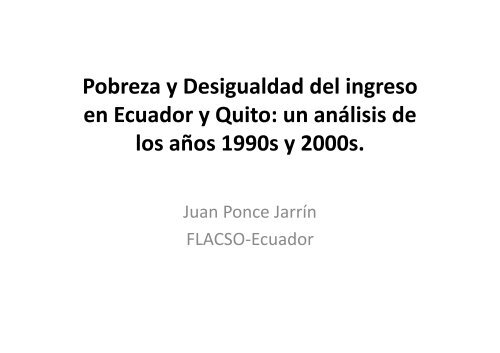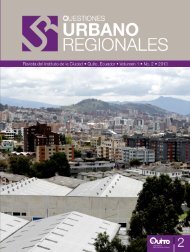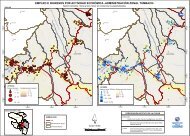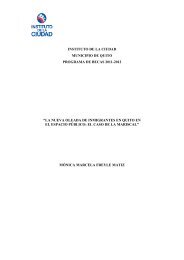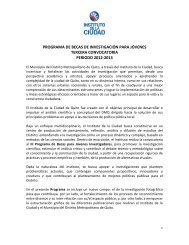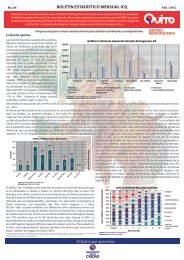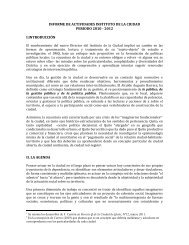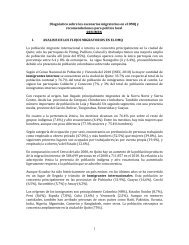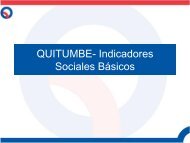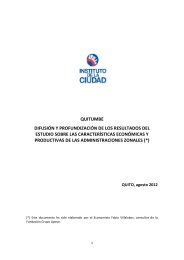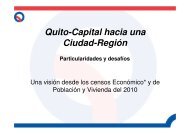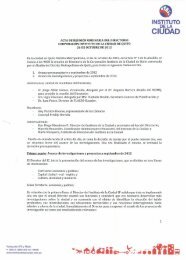Pobreza y desigualdad - Juan Ponce.pdf - Instituto de la Ciudad
Pobreza y desigualdad - Juan Ponce.pdf - Instituto de la Ciudad
Pobreza y desigualdad - Juan Ponce.pdf - Instituto de la Ciudad
You also want an ePaper? Increase the reach of your titles
YUMPU automatically turns print PDFs into web optimized ePapers that Google loves.
<strong>Pobreza</strong> y Desigualdad <strong>de</strong>l ingreso<br />
en Ecuador y Quito: un análisis <strong>de</strong><br />
los años 1990s y 2000s.<br />
<strong>Juan</strong> <strong>Ponce</strong> Jarrín<br />
FLACSO‐Ecuador
Introducción<br />
• Se analiza <strong>la</strong> evolución <strong>de</strong> <strong>la</strong> pobreza y <strong>la</strong><br />
<strong><strong>de</strong>sigualdad</strong> en Ecuador y en Quito durante <strong>la</strong><br />
década <strong>de</strong> los 1990s y <strong>la</strong> década <strong>de</strong>l 2000.<br />
• Incremento <strong>de</strong> <strong>la</strong> pobreza y <strong><strong>de</strong>sigualdad</strong> durante<br />
los 1990s y una reducción durante los 2000s.<br />
• Se analiza los factores asociados tanto con el<br />
incremento en los 1990s, como con <strong>la</strong> reducción<br />
en los 2000.<br />
• Se usa <strong>la</strong>s encuesta <strong>de</strong> empleo y <strong>de</strong>sempleo
Evolución <strong>de</strong>l coeficiente <strong>de</strong> Gini <strong>de</strong>l<br />
ingreso per cápita <strong>de</strong>l hogar<br />
Año Nacional Urbano Rural Quito<br />
1990 0.45 0.50<br />
1991 0.49 0.51<br />
1992 0.48 0.48<br />
1993 0.51 0.50<br />
1994 0.50 0.52<br />
1995 0.49 0.49<br />
1996 0.47 0.45<br />
1997 0.48 0.49<br />
1998 0.49 0.48<br />
1999 0.53 0.55<br />
2000 0.57 0.55 0.538 0.54<br />
2001 0.60 0.59 0.538 0.51<br />
2002 0.53 0.52<br />
2003 0.56 0.54 0.493 0.58<br />
2004 0.57 0.54 0.488 0.54<br />
2005 0.55 0.52 0.494 0.55<br />
2006 0.53 0.50 0.476 0.47<br />
2007 0.55 0.52 0.501 0.49<br />
2008 0.51 0.48 0.479 0.44<br />
2009 0.50 0.48 0.454 0.50<br />
2010 0.51 0.49 0.45 0.51
Evolución <strong>de</strong>l coeficiente <strong>de</strong> Gini<br />
0,65<br />
0,6<br />
0,55<br />
Quito<br />
Nacional<br />
0,5<br />
Urbano<br />
Rural<br />
0,45<br />
0,4<br />
1990 1991 1992 1993 1994 1995 1996 1997 1998 1999 2000 2001 2002 2003 2004 2005 2006 2007 2008 2009 2010
Evolución <strong>de</strong> <strong>la</strong> inci<strong>de</strong>ncia <strong>de</strong> <strong>la</strong><br />
pobreza<br />
Año Urbano Nacional Rural Quito<br />
1990 51.7% 47.0%<br />
1991 46.7% 39.2%<br />
1992 46.1% 37.2%<br />
1993 39.9% 30.7%<br />
1994 40.3% 27.7%<br />
1995 30.3% 17.5%<br />
1996 31.7% 20.1%<br />
1997 29.2% 18.3%<br />
1998 44.3% 27.5%<br />
1999 47.4% 36.0%<br />
2000 41.8% 31.3%<br />
2001 33.4% 42.9% 60.2% 19.2%<br />
2002 22.8% 10.0%<br />
2003 28.6% 39.1% 59.4% 11.2%<br />
2004 22.4% 33.6% 56.2% 9.1%<br />
2005 20.5% 31.3% 52.7% 11.2%<br />
2006 16.5% 26.9% 47.3% 6.8%<br />
2007 14.4% 25.7% 48.0% 6.0%<br />
2008 14.3% 24.9% 45.9% 6.2%<br />
2009 16.4% 25.6% 43.6% 7.9%<br />
2010 14.3% 22.7% 39.1% 7.7%
Inci<strong>de</strong>ncia <strong>de</strong> <strong>la</strong> pobreza<br />
70,0%<br />
60,0%<br />
Rural<br />
50,0%<br />
Urbano<br />
40,0%<br />
Quito<br />
Nacional<br />
30,0%<br />
20,0%<br />
10,0%<br />
0,0%<br />
1990 1991 1992 1993 1994 1995 1996 1997 1998 1999 2000 2001 2002 2003 2004 2005 2006 2007 2008 2009 2010
10%<br />
8%<br />
6%<br />
4%<br />
2%<br />
0%<br />
‐2%<br />
‐4%<br />
‐6%<br />
‐8%<br />
El crecimiento económico<br />
1990<br />
1991<br />
1992<br />
1993<br />
1994<br />
1995<br />
1996<br />
1997<br />
1998<br />
1999<br />
2000<br />
2001<br />
2002<br />
2003<br />
2004<br />
2005<br />
2006<br />
2007<br />
2008<br />
2009<br />
2010
Calidad <strong>de</strong>l crecimiento: 1990‐2000<br />
1 2 3 4 5 6<br />
0 20 40 60 80 100<br />
Percentiles<br />
Median spline Mean growth rate for poorest p%
Calidad <strong>de</strong>l crecimiento: 2000‐2006<br />
20 22 24 26 28<br />
0 20 40 60 80 100<br />
Percentiles<br />
Median spline Mean growth rate for poorest p%
Calidad <strong>de</strong>l crecimiento: 2006‐2010<br />
5 5.5 6 6.5<br />
0 20 40 60 80 100<br />
Percentiles<br />
Median spline Mean growth rate for poorest p%
Cambios en <strong>la</strong> estructura <strong>de</strong>mográfica.<br />
Perceptores por hogar<br />
Decil 1990 1993 1996 2000 2003 2006 2010<br />
Decil más<br />
pobre 1.3 1.4 1.3 1.6 1.7 1.9 1.6<br />
2 1.4 1.7 1.6 2.0 2.0 2.2 1.8<br />
3 1.7 1.8 1.6 2.2 2.1 2.2 2.0<br />
4 1.8 2.1 1.9 2.2 2.1 2.3 2.1<br />
5 2.0 2.1 2.1 2.3 2.4 2.4 2.2<br />
6 2.1 2.2 2.2 2.2 2.3 2.4 2.3<br />
7 2.2 2.4 2.1 2.4 2.3 2.4 2.4<br />
8 2.3 2.4 2.3 2.3 2.3 2.4 2.3<br />
9 2.3 2.4 2.3 2.3 2.3 2.3 2.3<br />
Decil más rico 2.3 2.4 2.3 2.2 2.3 2.3 2.2<br />
Total urbano 1.8 1.9 1.8 2 2.1 2.2 2.1
Cambios en el empleo: horas<br />
promedio a <strong>la</strong> semana<br />
Decil 1990 1993 1996 2000 2003 2006 2010<br />
Decil más<br />
pobre 41.5 44.1 44.1 39.2 37.9 35.4 36.1<br />
2 43.0 44.8 46.5 42.9 40.2 40.1 40.5<br />
3 41.7 43.6 46.5 45.5 43.2 42.9 42.9<br />
4 43.1 44.6 46.4 45.4 43.2 42.1 43.1<br />
5 41.9 43.9 46.7 45.4 44.5 43.9 43.8<br />
6 43.6 44.9 46.9 46.0 45.2 44.4 43.2<br />
7 43.1 47.7 47.5 48.3 47.5 44.6 43.5<br />
8 43.8 44.8 47.3 46.7 47.5 45.6 44.5<br />
9 44.2 45.5 47.4 44.7 45.0 44.9 44.3<br />
Decil más<br />
rico 44.2 45.2 49.0 47.0 45.0 44.9 43.8<br />
Total urbano 43.2 45.0 47.2 45.7 44.4 43.4 42.9
Cambios en el empleo: sector<br />
mo<strong>de</strong>rno<br />
Decil 1990 1993 1996 2000 2003 2006 2010<br />
Decil más<br />
pobre 45.6% 46.9% 49.2% 40.8% 43.3% 33.3% 13.4%<br />
2 53.0% 48.9% 45.3% 41.8% 42.3% 32.1% 23.5%<br />
3 51.5% 49.7% 51.2% 44.8% 46.5% 40.0% 30.3%<br />
4 51.8% 47.4% 45.6% 45.4% 48.5% 41.4% 34.6%<br />
5 55.5% 49.9% 54.2% 50.8% 46.5% 44.9% 41.4%<br />
6 52.1% 51.5% 53.9% 47.9% 54.5% 48.9% 45.6%<br />
7 51.2% 54.5% 56.8% 53.1% 53.4% 54.7% 51.5%<br />
8 56.1% 57.6% 59.2% 52.9% 58.2% 58.9% 55.9%<br />
9 57.3% 58.3% 63.5% 63.8% 65.4% 63.6% 63.3%<br />
Decil más rico 65.7% 61.6% 64.7% 68.9% 71.5% 73.7% 73.9%<br />
Total urbano 55.2% 53.8% 55.8% 53.5% 55.4% 52.2% 48.4%
Aumento <strong>de</strong> <strong>la</strong> brecha entre formal e<br />
informal.<br />
Año Hombres Mujeres<br />
1990 0.0561* 0.0977*<br />
1993 0.0964* 0.2708*<br />
1996 0.1334* 0.4249*<br />
2000 0.1956* 0.345*<br />
2003 0.3187* 0.4286*<br />
2006 0.2959* 0.4356*<br />
2010 0.402* 0.5701*
Reducción <strong>de</strong> <strong>la</strong> brecha entre<br />
calificados y no calificados<br />
Año Hombres Mujeres<br />
1990 0.5354* 0.3715*<br />
1993 0.6796* 0.3999*<br />
1996 0.6278* 0.3813*<br />
2000 0.7896* 0.5762*<br />
2003 0.7198* 0.6057*<br />
2006 0.6374* 0.5657*<br />
2010 0.5745* 0.422*
Transferencias a los hogares: BDH<br />
2000 2003 2006 2010<br />
Decile Urban Rural Urban Rural Urban Rural Urban Rural<br />
Poorest <strong>de</strong>cile 18.0% 11.8% 21.0% 12.6% 22.4% 12.3% 19.8% 8.6%<br />
2 16.3% 10.5% 18.4% 10.6% 20.4% 10.7% 16.9% 8.8%<br />
3 14.0% 9.0% 14.0% 11.5% 15.6% 11.6% 17.6% 13.2%<br />
4 14.9% 11.1% 13.8% 12.1% 12.9% 11.1% 14.2% 10.1%<br />
5 11.6% 11.0% 12.3% 11.2% 11.5% 11.5% 10.9% 11.9%<br />
6 6.9% 10.3% 7.3% 11.2% 7.8% 11.7% 9.4% 10.9%<br />
7 7.0% 9.8% 6.5% 10.3% 5.2% 10.5% 6.5% 11.1%<br />
8 4.9% 7.7% 4.1% 8.9% 2.7% 9.2% 3.0% 10.1%<br />
9 4.6% 9.7% 2.1% 7.5% 0.8% 7.3% 1.3% 9.2%<br />
Richest <strong>de</strong>cile 1.8% 8.9% 0.5% 4.2% 0.7% 4.1% 0.3% 6.2%
Remesas<br />
2000 2003 2006 2010<br />
Decile Urban Rural Urban Rural Urban Rural Urban Rural<br />
Poorest <strong>de</strong>cile 1.4% 0.9% 0.2% 0.1% 0.9% 0.3% 1.0% 0.3%<br />
2 2.3% 0.9% 0.8% 0.4% 2.2% 0.9% 1.6% 2.3%<br />
3 3.0% 1.9% 2.3% 1.3% 2.9% 1.1% 2.9% 3.0%<br />
4 3.4% 2.1% 3.0% 1.7% 3.2% 1.1% 4.5% 3.1%<br />
5 2.4% 2.6% 3.6% 3.0% 4.5% 3.8% 9.3% 6.4%<br />
6 5.4% 4.0% 5.6% 4.5% 5.3% 6.1% 8.9% 9.6%<br />
7 6.3% 7.6% 10.1% 6.6% 10.2% 7.0% 9.9% 7.9%<br />
8 13.3% 8.4% 13.7% 11.7% 13.8% 8.2% 8.9% 16.5%<br />
9 17.5% 15.6% 18.9% 19.9% 19.3% 19.7% 14.3% 22.6%<br />
Richest <strong>de</strong>cile 45.1% 56.1% 41.8% 50.7% 37.6% 51.8% 38.7% 28.0%
Descomposición <strong>de</strong>l Gini<br />
Labor income Property income Remittances Cash transfers<br />
margina<br />
marginal<br />
marginal<br />
marginal<br />
Share l effect share effect share effect share effect<br />
1990 0.8998 -0.0355 0.1002 0.0355<br />
(0.0025) (0.0025)<br />
1993 0.9133 -0.0101 0.0867 0.0101<br />
(0.002) (0.0020)<br />
1996 0.9038 -0.0056 0.0962 0.0056<br />
(0.0012) (0.0012)<br />
2000 0.8852 -0.0123 0.0617 0.0145 0.0453 0.0086 0.0077 -0.0108<br />
(0.0066) (0.0021) (0.0067) (0.0002)<br />
2003 0.8784 -0.0038 0.0773 0.0095 0.0372 0.0057 0.0071 -0.0114<br />
(0.0024) (0.0021) (0.0012) (0.0002)<br />
2006 0.8679 -0.0146 0.0953 0.0189 0.0325 0.0031 0.0043 -0.0075<br />
(0.0019) (0.0018) (0.0011) (0.0001)<br />
2010 0.8559 0.0036 0.1167 0.0153 0.0173 -0.0023 0.0101 -0.0166<br />
(0.0034) (0.0031) (0.0006) (0.0002)
Conclusiones<br />
• Durante los años 1990 se tiene bajos niveles <strong>de</strong><br />
crecimiento acompañados <strong>de</strong> un tipo <strong>de</strong><br />
crecimiento concentrador (pro‐rico). Por otro<br />
<strong>la</strong>do, durante los 2000 hay mejores niveles <strong>de</strong><br />
crecimiento, así como un crecimiento pro‐pobre.<br />
• Los cambios en <strong>la</strong> estructura <strong>de</strong>mográfica <strong>de</strong> los<br />
hogares no habrían jugado un papel importante<br />
en <strong>la</strong> explicación <strong>de</strong> los cambios en <strong>la</strong><br />
concentración <strong>de</strong>l ingreso.
Conclusiones<br />
• Existen elementos estructurales que presionan<br />
hacia un incremento <strong>de</strong> <strong>la</strong> <strong>de</strong>sigua<strong>la</strong>d en los<br />
ingresos.<br />
• Ten<strong>de</strong>ncia <strong>de</strong> <strong>la</strong>rgo p<strong>la</strong>zo al incremento <strong>de</strong> <strong>la</strong><br />
informalidad <strong>la</strong>boral, e incremento <strong>de</strong> <strong>la</strong> brecha<br />
<strong>de</strong> ingresos <strong>la</strong>borales entre los trabajadores <strong>de</strong>l<br />
sector mo<strong>de</strong>rno y los trabajadores <strong>de</strong>l sector<br />
informal.<br />
• Este incremento se acentúa en <strong>la</strong> segunda mitad<br />
<strong>de</strong> <strong>la</strong> década <strong>de</strong>l 2000 y constituye un importante<br />
l<strong>la</strong>mado <strong>de</strong> atención para <strong>la</strong> política pública.
Conclusiones<br />
• Sin embargo, también se encuentra elementos<br />
que presionan hacia una reducción en <strong>la</strong><br />
<strong><strong>de</strong>sigualdad</strong> <strong>de</strong>l ingreso.<br />
• La reducción <strong>de</strong> <strong>la</strong> brecha <strong>de</strong> ingresos <strong>la</strong>borales<br />
entre trabajadores calificados y no calificados<br />
durante <strong>la</strong> década <strong>de</strong>l 2000.<br />
• Las transferencias monetarias, tanto públicas<br />
(Bono <strong>de</strong> Desarrollo Humano) como privadas (<strong>la</strong>s<br />
remesas <strong>de</strong> los migrantes), habrían influido en <strong>la</strong><br />
reducción <strong>de</strong> <strong>la</strong> inequidad en especial en <strong>la</strong><br />
segunda mitad <strong>de</strong> <strong>la</strong> década <strong>de</strong>l 2000


